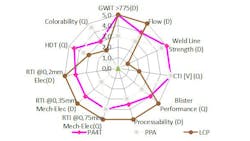High-Performance Thermoplastics Increase Terminal-Block Sustainability
“Sustainable design,” the philosophy of designing products to comply with the principles of social, economic, and ecological sustainability, has been gaining significant interest in the electronics industry. In concert with continued attention on reducing energy consumption, original equipment manufacturers (OEMs) are placing greater restrictions on the use of halogens as flame-retardant substances in plastics. This article considers the requirements now placed on high-temperature plastics used for terminal blocks, and some of the possible solutions.
Global market estimates for terminal blocks in 2014 were around $2.8 billion. Demand will continue to grow for the foreseeable future, driven by greater market penetration in developing countries, as well as increased automation and urbanization. Terminal blocks of all types need to conform to the UL 1059 terminal block standard to ensure their safety. This is because the connectors can often be assembled on the spot, leaving open the increased possibility of a wrong termination. One prime example of such connectors are those utilized in LED lighting—currently the fastest growing connection system in the terminal-block family.
This file type includes high resolution graphics and schematics when applicable.
Through-Hole Reflow vs. Wave Soldering
No segment of the market is stronger than terminal blocks made in halogen-free thermoplastics resistant to through-hole reflow (THR) soldering temperatures. When compared with earlier generations of terminal blocks assembled using wave soldering, the thermoplastic terminal blocks meet demands for improved electrical performance and increased lifetime, and lower system cost through ease of assembly. The entire printed-circuit-board (PCB) assembly stage now requires one single reflow process that’s applied for integrated circuits and terminal blocks. (Traditionally, ICs have been soldered first in reflow soldering, followed by a second-wave soldering process.)
Reflow soldering is also much more reliable. Reject rates with THR, and surface-mount technology (SMT), are less than a tenth of the norm with wave soldering—around four parts per million versus 50 ppm for wave/hand soldering.
The main issue with rejected components concerns a weak or defective soldering joint or a blistered terminal block, both of which are usually discovered only after assembly. Therefore, using a robust material that’s stable for soldering and better suited to SMT and THR can significantly reduce processing costs.
Halogen-Free Plastics
Halogen-free plastics provide advantages to terminal blocks both during and after their working lifetimes. Not only can they be recycled or disposed of more easily than halogen-containing plastics, they also dramatically boost electrical performance in active terminal blocks. This is demonstrated by the Comparative Tracking Index (CTI), a measure of the electrical breakdown (tracking) properties of an insulating material. CTI values for halogen-free plastics are in the range of 600 V, compared to 200 to 300 V in standard halogenated terminal-block housings. Such high CTI values enable ultra-low electrical surface tracking and, hence, help foster more robust designs, particularly in terms of very low creep distances.
Overall, terminal-block makers require a housing material that’s consistently capable of withstanding reflow processing conditions. This material should also meet such needs as high flow for production of thin-walled components, very good mechanical performance, and high flame retardancy, as well as comply with global environmental regulations.
Various halogen-free, high-performance thermoplastics can more or less meet these challenges. Until quite recently, the default choice was liquid-crystal thermoplastics (LCPs), since very few other materials could cost-effectively meet application requirements. Today, entirely halogen-free, high-performance polyamides are available that meet the most stringent requirements for reflow terminal blocks.
In fact, specific grades of a polyamide known as Polyamide 4T (a semi-crystalline semi-aromatic polyamide) are the only ones to currently conform with IEC 60335-1 ratings from the VDE (Association for Electrical, Electronic & Information Technologies) for use in unattended appliances. These include items such as dishwashers, and ovens, washing machines, and HVAC equipment. This conformity is particularly important, since an increasing number of companies producing and using terminal blocks include IEC 60335-1 ratings in their specifications.
Polyamide 4T
Halogen-free grades of Polyamide 4T meet the most stringent requirements for terminal blocks to produce robust and reliable plastic housings, while enabling power connections that easily go up to 600 V and 16 A.
Polyamide 4T demonstrates excellent performance during reflow soldering. It was in fact developed to meet the moisture-sensitivity level MSL2, according to IPC/JEDEC J-STD 020D, which classifies materials according to their moisture sensitivity. Polyamide 4T has a very high deflection temperature (HDT) under load of over 300°C, low moisture uptake, and very high stiffness, all of which combined provide very good blistering resistivity. This means that the material has an extended floor life under factory conditions with no need for dedicated component packaging. Defects during assembly are extremely low.
The UL 1059 standard for terminal blocks includes specifications relating to “RTI (Relative Temperature Index) electrical,” associated with critical insulating properties, and to “RTI mechanical strength.” (The latter relates to strength, where impact resistance and flexibility are not essential; it differs from “RTI mechanical impact,” which is associated with the impact resistance, resilience, and flexibility of a material.) The standard, applied to the thinnest wall of the terminal block, associates with the lowest RTI value of a given material (electrical or mechanical strength).
A recently developed grade of Polyamide 4T featured an RTI electrical of 120°C at a wall thickness of 0.35 mm, and an RTI mechanical strength of 110°C at the same thickness. Some LCPs also come with similar characteristics, but they’re generally let down by inferior CTI. While all LCPs only comply with Performance Level Category (PLC) class 3 (CTI 175-249V), Polyamide 4T qualifies for the highest PLC class 0 with its CTI of 600 V. Advantages of that PLC rating include a significantly higher possible current on high-density terminal blocks, and reduced risk of electrical failures due to surface-induced shortcuts in use.
The minimum required creepage distance—the distance between two pins—on the surface of a terminal depends on the material’s CTI. With Polyamide 4T, it’s possible to create designs with creepage distances almost seven times shorter than when using LCP. This contributes to a much simpler design as well as to material saving in the housing.
Alternative materials include other types of high-performance semi-aromatic polyamides known as polyphthalamides (PPAs) as well as LCPs. Polyamide 4T outperforms all LCPs in terms of mechanical and electrical strength, and it has better blistering performance and much better long-term heat aging than any currently available PPA (see the figure).
Polyamide 4T even delivers outstanding thermal and mechanical performance in very small components, as well as an all-color rated UL94 V-0 flame retardancy at wall thicknesses down to 0.2 mm. Accelerated testing at high temperatures over several thousand hours has shown that component lifetimes should be considerably in excess of those required by specifiers.
This file type includes high resolution graphics and schematics when applicable.
The pitch size reduction in new designs of terminal blocks, down from 3.5 to 2.5 mm, makes the need for mechanical strength, pin retention force, electrical properties, and flow in the block material greater than ever. Polyamide 4T meets these needs. It is, in fact, the only material that can be fully used in SMT terminal blocks and has an all-color (including white) VDE approval down to 0.4 mm.



